Note
Ancient Egyptians were black. Enough said.
Hi there! Uh yeah, they definitely were? I’m not sure if you were just remarking on that or if this was in regards to something specific on this blog - as far as I’m aware I’ve not posted anything to the contrary.
On another note to all my followers, sorry for the lengthy absence from here! I am a uni student and have been very busy with my courses. That being said, those courses have given me a ton of new ideas and material for the blog, and after Christmas I’ll be starting things back up again, so stay tuned!
4 notes
·
View notes
Photo
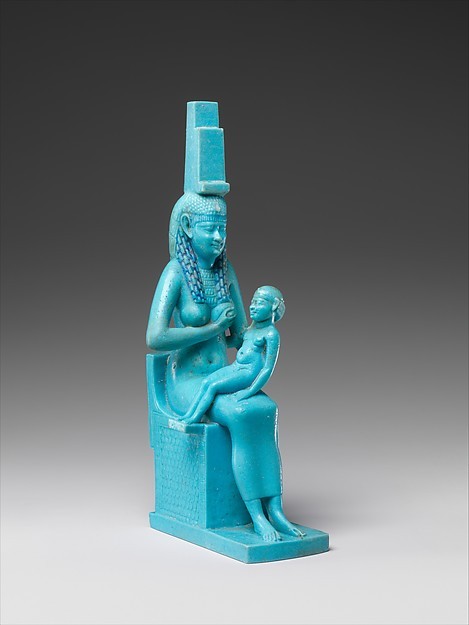
Isis and Horus statuette, Ptolemaic Period, 332-30 BC. Faience.
This small statuette depicts Isis suckling her son Horus, which is a popular image that symbolised rebirth in ancient Egyptian culture. Isis is depicted with full breasts and wearing the vulture headdress that goddesses and queens wore. The throne glyph on top of her head represents the hieroglyphic word for her name. Her son, the god Horus, is depicted as a child, naked and with a large stomach.
Sourced from the Met Museum’s online collection.
69 notes
·
View notes
Text
I want to study ancient Egypt. Where should I start?
This is part two of an answer to an ask sent in by an anon who was wanting to study ancient Egypt from its chronological beginnings.
When studying ancient Egypt, it’s easy to get overwhelmed by the sheer amount of topics and information to sift through. For the purposes of this post/ask, I’m going to assume that you are not interested in studying as part of a course, but rather in your own time.
First off, you’re going to be reading a LOT. It’s good to amass a small library of sorts for all your references, though you can find a lot of older books online in pdf form for free.
Here are some books that you might find useful:
Note - you do not need all these books. Rather, these are some that would come in handy to those wanting to build a basic Egyptology reference library at home.
General
Baines, John / Malek, Jaromir, Cultural Atlas of Ancient Egypt.
Manley, Bill, The Penguin Atlas of Ancient Egypt.
Murnane, William J. The Penguin Guide to Ancient Egypt.
Shaw, Ian, The British Museum Dictionary of Ancient Egypt.
Shaw, Ian. Ancient Egypt: A Very Short Introduction.
Schulz, R. / Seidel, M. (eds.) Egypt: World of the Pharaohs.
Wilkinson, Richard H. (ed.) Egyptology Today.
The Shire Egyptology series are also an excellent resource! They cost around $10-15 AUD each and cover a wide range of topics. They are really great for someone wanting an introductory approach to various topics of interest for ancient Egypt.
Religion
Assmann, Jan, The Search for God in ancient Egypt.
Grajetzki, Wolfram, Burial Customs in Ancient Egypt.
Hart, George, The Routledge Dictionary of Egyptian Gods and Goddesses .
Hornung, Eric, Conceptions of God in Ancient Egypt. The One and the Many.
Kanawati, Naguib. The Tomb and Beyond: Burial Customs of Egyptian Officials.
Wilkinson, Richard H., The Complete Temples of Ancient Egypt.
Predynastic and Early Dynastic Egypt
Now if you want to start off with Predynastic and Early Dynastic Egypt, these would come in handy:
Adams, Barbara. Predynastic Egypt. (from the Shire Egyptology series, great one to start with!)
Midant-Reynes, Beatrix. The Prehistory of Egypt.
Spencer, A. Jeffrey. Early Egypt: The Rise of Civilisaton in the Nile Valley.
Wilkinson, Toby. Early Dynastic Egypt.
Archaeology
Bahn, Paul. The Penguin Archaeology Guide.
Catling, Christopher and Bahn, Paul. The Illustrated Practical Encyclopedia of Archaeology (not very detailed for Egypt, but great basic resource and easy to read).
Johnson, Matthew. Archaeological Theory: An Introduction.
Reid, Donald Malcolm. Whose Pharaohs? Archaeology, Museums, and Egyptian National Identity from Napoleon to World War I.
Wendrich, Willeke. Egyptian Archaeology.
Art and architecture
Arnold, Dieter. Building in Egypt: Pharaonic Stone Masonry.
Arnold, Dieter, The Encyclopedia of Ancient Egyptian Architecture.
Lehner, Mark, The Complete Pyramids.
Robins, Gay, The Art of Ancient Egypt.
Schäfer, Heinrich, Principles of Egyptian Art.
For literature and hieroglyphs, take a look at part one of this post and this post.
Hope this is of some help! If you would like any clarification on the above points or have another question you’d like to ask, feel free to send in an ask!
337 notes
·
View notes
Note
What are your favorite topics, gods, goddesses to study within the ancient Egypt realm? I'm looking to start from the creation of it's existence.
This question has been sitting in the inbox for awhile, so sorry anon! Uni has started up again in the last few weeks, which is also why the blog has been a bit sluggish lately. I will do up some more posts for the queue though!
There’s a LOT of angles to come from when studying ancient Egypt, but really it depends on what you find the most interesting. For myself, learning hieroglyphs has probably been my favourite (but also the most difficult) thing to learn so far. If you’re interested in learning hieroglyphs, this post might point you towards where you can start. I also found it really fascinating to study ancient Egyptian literature; there are numerous books like this one which contain generally reliable English translations that are easy to read! Lictheim has three volumes on the literature divided by period and they are more extensive, but they’re a bit outdated as they were written in the 1970′s, plus Simpson’s version is a lot more friendly to the average reader; it’s my favourite, anyway.
Other favourite topics of mine include Egyptian art, doing case studies of specific tombs (although architecture is probably one of my weaknesses), and archaeology. My favourite tomb at the moment is an 18th Dynasty tomb belonging to a noble called Sennedjem in Deir el-Medina (seriously google it because it is AMAZING).
In terms of gods and goddesses, my faves would probably be Sekhmet, Pakhet, Bast, Isis, Hathor, Horus, etc. I don’t really a specific favourite, though I have a weakness for the leonine/feline deities (what can I say, I’m a cat person. Plus Sekhmet and Pakhet are pretty bad ass). Religion is probably one of the topics that I have gaps in my knowledge for, though I am taking an Egyptian Religion unit next semester which I’ve been looking forward to for forever!
In terms of which period is my favourite, I can’t really choose. I know a fair bit about Early Dynastic and the Old Kingdom, but most of the literature we have is from the Middle Kingdom onwards, which is one of my favourite things to study. Surprisingly, I studied Coptic Egypt last year and found it really interesting, though the teacher was terrible.
This has gone way too long so I’m going to answer the other part of your question as to where you should start in another post!
#asks#anon#sorry guys once you get me talking about Egypt I won't stop#I held back so much too#and still I managed to ramble on for ages#also I love questions so if you don't mind me taking a little while to answer them feel free to send some in!
11 notes
·
View notes
Photo
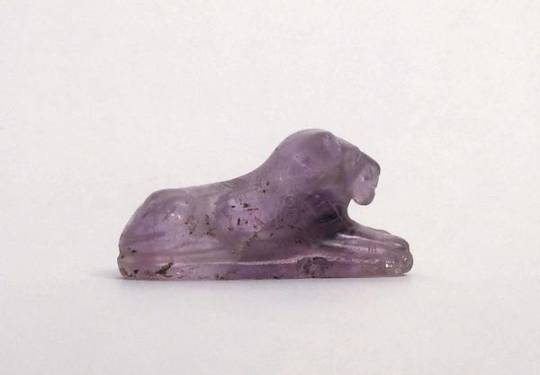
Amethyst Amulet of a Lion, 12th Dynasty (1961-1917 BC).
This amulet, originally from Thebes, has a hole running through its length so it could be worn on a string. It has inscriptions on the bottom that contain Senwosret I's name as well as the epithet 'Beloved by the Souls [Gods or Ancient Kings] of Heliopolis'.
Sourced from the Met Museum.
86 notes
·
View notes
Text
What is Egyptian Art?
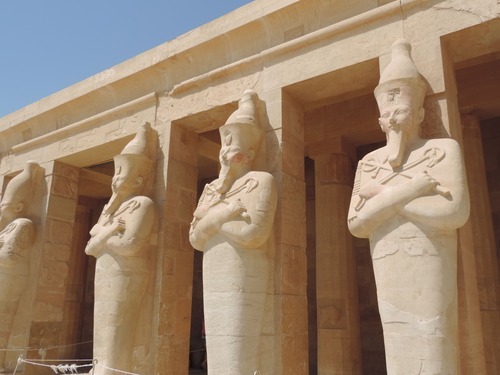
The concept of art that we have today is difficult to apply to ancient Egypt. Monuments, statues, and other representational objects were of a primarily functional nature, though the aesthetic aspect was clearly taken into consideration. What we term as their 'art' served a specific purpose - images of the deceased represented in various activities were created as a intermediary tool between the dead and the living, and to ensure their preservation in the afterlife. Offerings for the dead being depicted in art ensured their existence for the deceased in the afterlife, and statues of deities were vessels through which the gods and goddesses could manifest.

So how do we define Egyptian art? More often than not the elements of Egyptian workmanship that come to mind are those that appeal to our contemporary tastes - we lump it in with our idea of modern art. However, a statue that has been poorly made with unbalanced proportions and stylised in a manner that may not be pleasing to the eye still performs the same function as a statue of the highest quality and workmanship does. The elite and members of the royal family could afford to commission/purchase work from the most skilled craftsmen of the period, and this shows in the comparison between a tomb belonging to a member of the 'common' class and one belonging to a beloved queen of the pharaoh. Both these tombs would have still performed the same functions.
The next post on Egyptian art will cover the Egyptian canon and the basic principles of the art that spanned the pharaonic period.
References:
Kemp, Barry J. Ancient Egypt: Anatomy of a Civilisation (2006).
Robins, Gay. The Art of Ancient Egypt (2008).
Photo credits belong to ancientegyptianhistory.tumblr.com
21 notes
·
View notes
Photo


Egyptian Faience Khnum Amulet, Third Intermediate to Late Period, c. 1069-525 BC
The striding ram-headed god is finely modeled, with hands clenched by his sides, wearing a shendyet-kilt, on an integral rectangular base, pierced for suspension.
Khnum was one of the earliest Egyptian deities, originally the god of the source of the Nile River. Since the annual flooding of the Nile brought with it silt and clay, and its water brought life to its surroundings, he was thought to be the creator of the bodies of human children, which he made at a potter’s wheel, from clay, and placed in their mothers’ wombs. He later was described as having moulded the other deities, and he had the titles Divine Potter and Lord of created things from himself. His significance led to early theophoric names of him, for children, such as Khnum-Khufwy – “Khnum is my Protector”, the full name of Khufu (r. 2589–2566 BC), builder of the Great Pyramid.
The worship of Khnum centered on two principal riverside sites, Elephantine Island and Esna, which were regarded as sacred. At the Elephantine temple, which dates to the Middle Kingdom (2055–1650 BC), he was worshipped alongside his daughter, Anuket and Satis, his consort, as the guardian of the source of the Nile River. At Esna, the temple dates to the Ptolemaic Period (323-30 BC), when the worship of Khnum flourished there.
719 notes
·
View notes
Photo


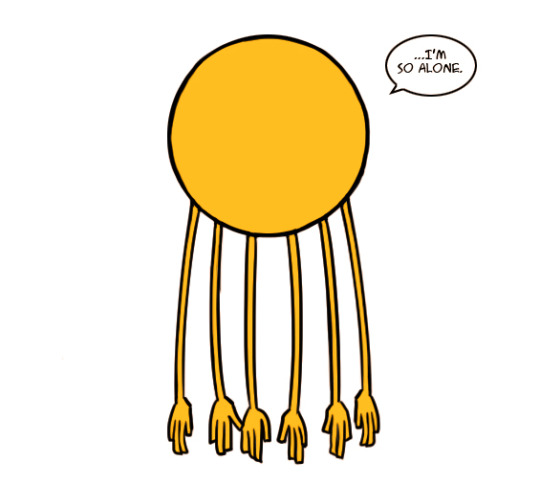
Stick-Gods ~ The Aten
1K notes
·
View notes
Photo

Composite capitals with volutes, Temple of Isis at Philae. The columns form part of the Roman kiosk built on the island by the Emperor Trajan (98-117 AD). Picture taken by me.
#ancient egypt#architecture#Roman#Ptolemaic Period#Roman Period#Graeco-Roman Period#column#capital#composite capital#volutes#original photo
26 notes
·
View notes
Photo
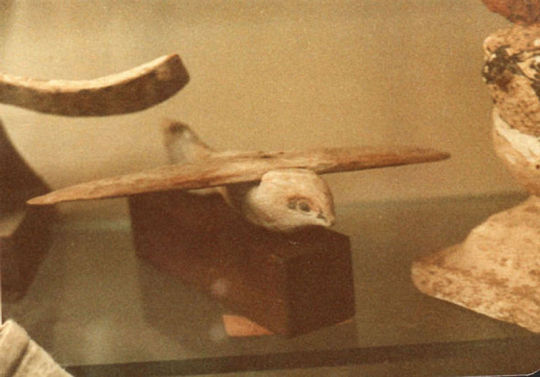
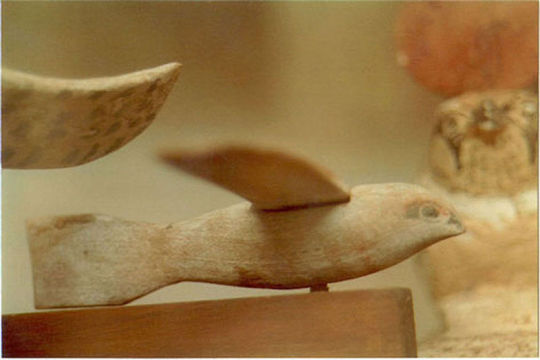
The Saqqara Bird is a bird-shaped artifact made of sycamore wood, discovered during the 1898 excavation of the Pa-di-Imen tomb in Saqqara, Egypt. It has been dated to approximately 200 BCE, and is now housed in the Museum of Egyptian Antiquities in Cairo.
335 notes
·
View notes
Photo
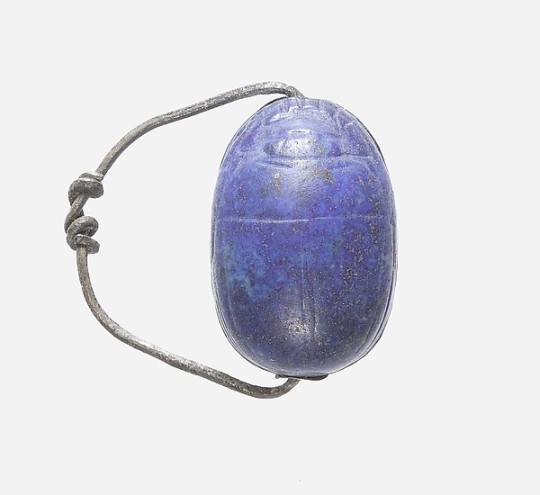
Scarab ring, 1850-1775 BC. Dynasty 12 or Early Dynasty 13
This ring, made of silver and lapis lazuli, dates back to the Middle Kingdom and was one of many objects found in 1904 by the Egypt Exploration Fund at Abydos.
#ancient egypt#scarab#ring#jewellery#Dynasty 12#Dynasty 13#Abydos#Middle Kingdom#EEF#Tomb#Tomb V21#silver#lapis lazuli
28 notes
·
View notes
Photo
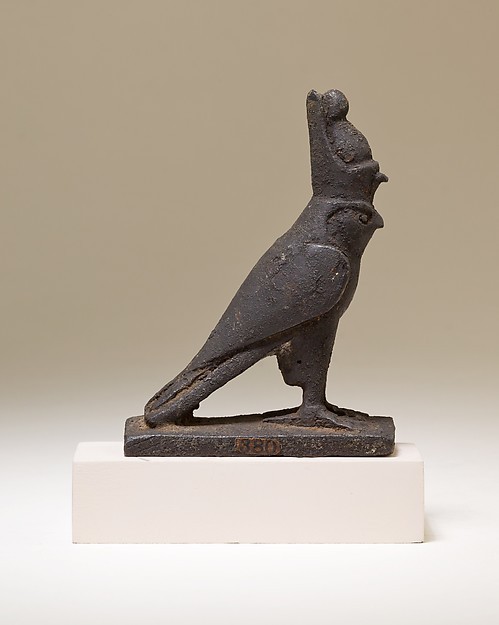
Horus falcon figure, 664-30 BC.
This copper statuette found in Abydos was probably made during the Ptolemaic or Late Period, and wears the double crown of Upper and Lower Egypt. Sourced from the Met Museum.
22 notes
·
View notes
Text
The Tomb of Hesy-re
Who was Hesy-re?
Hesy-re was a high court official during the 3rd Dynasty of the Old Kingdom. It is thought that he may be the one of the first recorded physicians in history, bearing the title 'Chief of Dentists and Physicians', and he also worked as a scribe.
Why is his tomb important?
This tomb is significant as it is a good architectural example of 3rd Dynasty tombs, but more importantly it contains an incredibly realistic and sophisticated level of art for the period which shows part of the emergence of the Egyptian canon in art. The beautiful wooden panels found in the tomb are a very rare find for the period and gives lots of valuable information to work with in our study of ancient Egyptian history.
The tomb was discovered by Auguste Mariette in the late 1860's at the northern Saqqara necropolis, but the main work of excavation was done by James Quibell during 1910-1912 in two seasons.
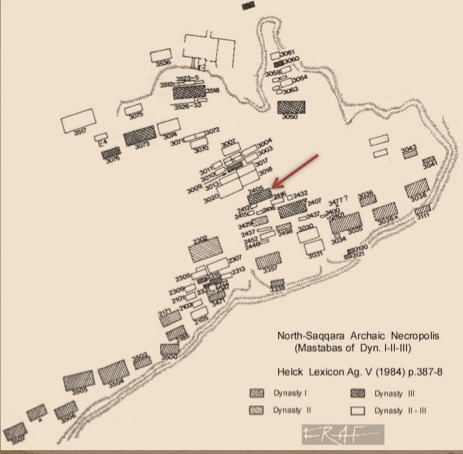
A 3rd Dynasty tomb, it was dated to the reign of Djoser by a clay sealing found in the burial chamber by Quibell.
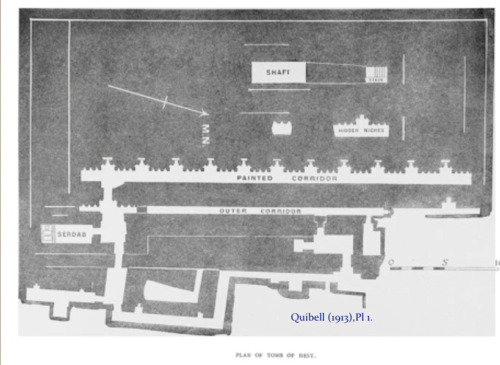
The tomb has a solid mud brick superstructure, which included a niched palace façade. Like elite tombs of the 2nd dynasty, the southernmost east niche was the most significant, giving way to a doorway leading into a painted corridor with more niches. At the rear of these niches, a carved wooden panel was placed (that's a lot of times to say niche in one paragraph!). These panels are probably the most significant element of the tomb, and they are gorgeous. But more on those later.
The palace façade was similar to Djoser's funerary complex at Saqqara.
Palace façades in elite tombs during the 3rd Dynasty were a throwback from the 1st Dynasty, and recalled the funerary architectural features of the Pharaoh. However, only some tombs had them - this suggests that a façade could have been a costlier and unnecessary part of tomb architecture for nobility at the time that could have served as an indicator of status, and linked the deceased with the pharaoh by emulating their tombs. Hesy-re was certainly favourable to the Pharaoh, with the quality of the art within his tomb suggestive of royal craftsmanship, as well as the many titles bestowed upon him and his prestigious status.
Painted patterns that imitated reed matting were still preserved on the façade - this patterning emulated earlier textures when reed matting was used to form the walls.
Burial Chamber
The chamber had been robbed in antiquity, and was half full of stone. Quibell discovered the fragmentary remains of 1-2 human skeletons, however they were eventually lost after the man sent down to retrieve them was attacked by a swarm of fleas and left the bones there. Now that's a new excuse to use for the next uncompleted assessment! Some grave goods and pottery were, despite the fleas, recovered.

Wooden Panels
6 wooden panels were recovered from the niches - five from Mariette and one from Quibell's excavation. They were originally 11 panels, but the others were too damaged to see anything but a few hieroglyphs, which sadly were not recorded and have been lost. The panels face towards the east, and serve the same function as the niche stones of the 2nd Dynasty - to perpetuate the existence of the deceased in the next world and provide the necessary offerings for it. They show the establishment of Egyptian conventions for drawing the human figure as well, and similarities to it can be seen in Djoser's reliefs.
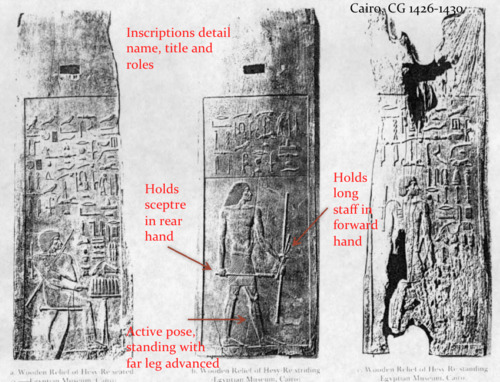
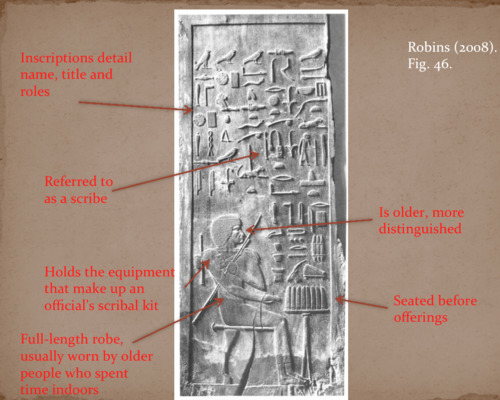
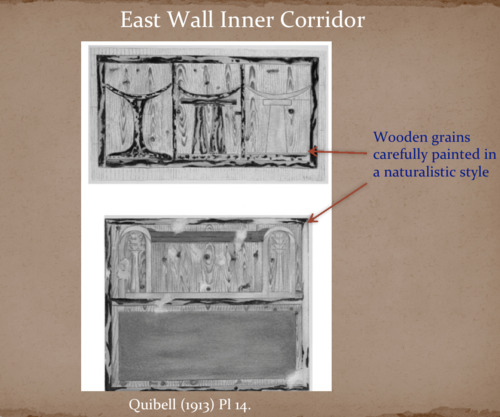
The paintings on the east wall of the inner corridor had depictions of games, funerary implements, tools and wooden furniture. On the west wall, of the outer corridor are the earliest known scenes suggestive of daily life - they include men with cattle and a crocodile.
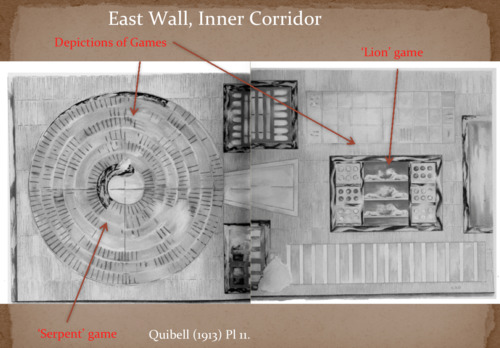
References
Forshaw, R. ‘Hesyre: The First Recorded Dental Physician and Surgeon in History’, Bulletin of the John Rylands Library Vol 89 (2013) pp. 181-193.
Grajetzki, W. Burial Customs in Ancient Egypt: Life in Death for Rich and Poor (London, 2003).
Kanawati, N. The Tomb and Beyond: Burial Customs of Egyptian Officials (Wiltshire, 2001).
Mariette, A and Gaston, C. Les mastabas de l'ancien empire: fragment du dernier ouvrage de Auguste Édouard Mariette. Georg Olms, 2006.
Midant-Reynes, B., The Prehistory of Egypt (Oxford, 2000; Engl. Transl. by Ian Shaw).
Quibell, J. E. Excavations at Saqqara, 1911-12: The Tomb of Hesy. Le Caire: l'Institut Français d'Archéologie Orientale, (Cairo, 1913).
Robins, G. The Art of Ancient Egypt (Hong Kong, 2008).
Saleh, M and Hourig, S. The Egyptian Museum, Cairo: Official Catalogue. Cairo, the Arabian Republic of Egypt: Organisation of Egyptian Antiquities: Mainz, Germany: Verlag Philipp von Zabern, 1987.
Smith, Williamson Stevenson. The Art and Architecture of Ancient Egypt.(Oxford, 1998).
Spencer, A. J. Death in Ancient Egypt (London, 1991).
Spencer, A. J. Early Egypt: The Rise in Civilisation in the Nile Valley (London, 1993).
Wilkinson, T.A.H., Early Dynastic Egypt (London/New York, 1999).
Wood, Wendy. "A Reconstruction of the Reliefs of Hesy-re." Journal of the American Research Center in Egypt (1978): 9-24.
#Tombs#Elite Tombs#ancient egypt#Old Kingdom#3rd Dynasty#Djoser#Elite#Art#Tomb Painting#Panels#Wood#Hesy-re#Hesy#Tomb#Archaeology#Saqqara#Tomb Thursday
14 notes
·
View notes
Photo
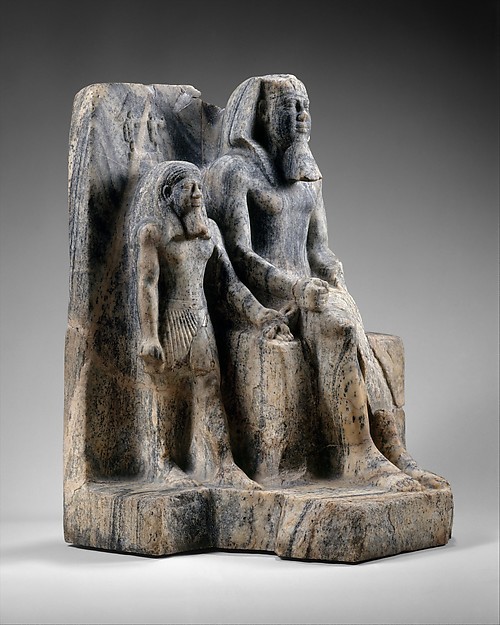
Gneiss Statuette of Sahure and a nome god, 2458-2446 BC.
This is the sole surviving example of Sahure in 3D art. Sahure was the second ruler of the 5th Dynasty. The king is seated on the throne, with the nome god beside him and offering him an ankh, symbolic of life. The archaic style and aged depiction of the king is characteristic of the Old Kingdom. Sourced from the Met Museum's online collection.
11 notes
·
View notes
Photo

Fragment of a relief of a large figure of Mentuhotep II. This was found in the the tomb of Khety in Deir el-Bahri and dates to the 11th Dynasty. This is one of the first examples of the king being depicted in a non-royal tomb at Thebes. Sourced from the Met Museum's online collection.
7 notes
·
View notes
Photo

These drinking cups are made from glassy faience and gold, and date to the reign of Thutmose III in the 18th Dynasty. The jar on the right was likely imported from Western Asia and could have been part of the dowry of one of the foreign wives of Thutmose III. Sourced from the Met Museum's online collection.
#art#drinking#cups#ancient egypt#glass#faience#gold#18th Dynasty#Thutmose III#New Kingdom#Asia#Trade
13 notes
·
View notes
Note
Macquarie University also offers ancient language programs to the public and to its students during the summer and winter holidays through MALS (Macquarie Ancient Languages School). You can learn a ton of different ancient languages like Hierolyphics, Akkadian, Hieratic, Latin, Ancient Greek, etc etc. If you're a student at the uni you get a reduced fee as well! The Beginner's Hiero course starts in a couple of days, so I don't know if it might be too late for you to enrol (if you even live in the country that is!), but they run it every year.
Like emthehistorygirl said, they also run a Diploma of Ancient Languages Course online, and you may have some options as an international student too if you don't live in Australia.
If you're looking for some books that you can use, Boyo's textbook mentioned above is a good one but it can be a little heavy to read especially if you're being introduced to hieroglyphs for the first time. A good one to start off with could be James Allen's Middle Egyptian: An Introduction to the Language and Culture of Hieroglyphs. Collier, Manley and Parkinson's How to Read Egyptian Hieroglyphs: A Step by Step Guide to Teaching Yourself is another option - it is by no means a fully comprehensive text, but it's great for introducing yourself to the basics. If you do get Ockinga's Middle Egyptian Grammar it doesn't come with answers to the exercises, but this page provides the answers with transliteration and translation in both English and German! If you want to get serious about learning hieroglyphs, you should invest in a copy of Faulkner's Concise Dictionary of Middle Egyptian. There is also the even more extensive Egyptian Grammar dictionary by Gardiner, but it is a bit outdated and you should be able to get by just fine with Faulkner's Concise Dictionary.
There's not a whole lot on basic online resources, I'm afraid, although there is this fantastic dictionary that you can search for signs by individual Gardiner code. I'm also planning to upload some resources onto this blog and do a few posts on the basics of hieroglyphs with exercises as well, if that might be of any interest to you!
Great blog! Just wondering, any suggestions as to where one could study hieroglyphics, preferably online... Thanks!
Thanks!!
I studied Hieroglyphics at university, I struggled with it a lot. I go to Macquarie University and was taught by two professors at the top of their field. We used the Text Book Middle Egyptian Grammar, written by Boyo Ockinga (who just happened to be one of my professors)
Depending on your location and level of higher education you could enrol in a Diploma of Ancient Languages, my university have a distance education or correspondence option where the unit can be taken entirely online.
Another option would be investing in a number of teach-yourself textbooks and guides and studying that way.
Hope I was of some help!! Good luck!!
12 notes
·
View notes